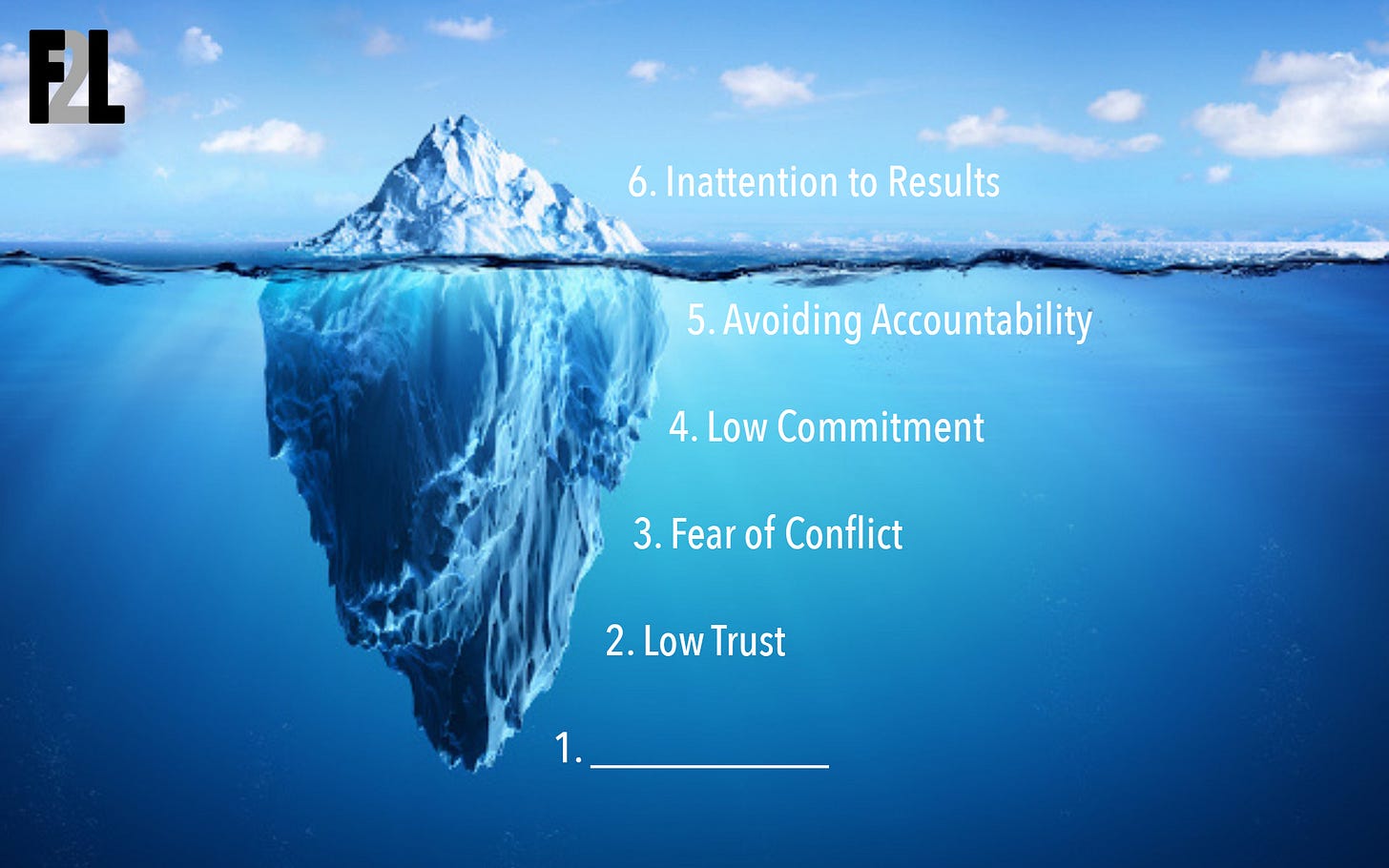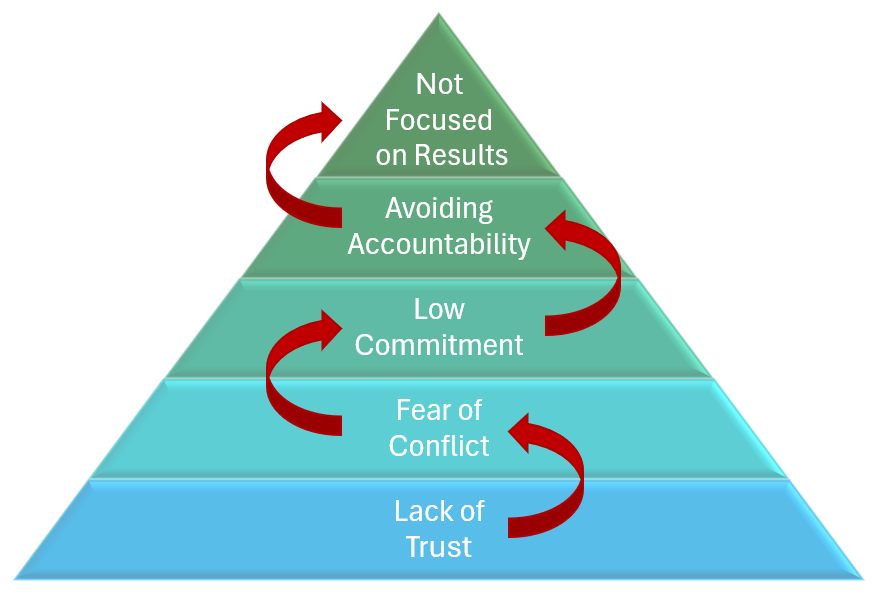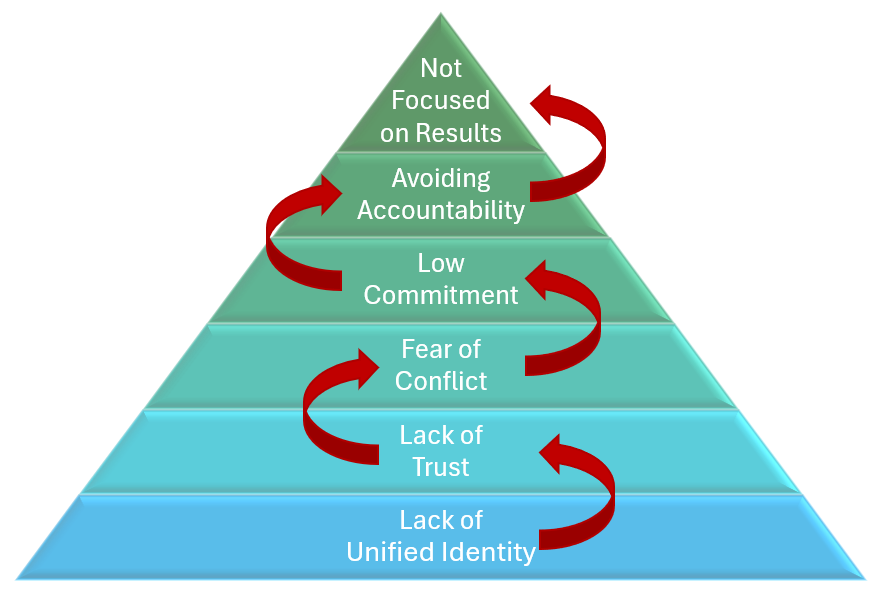The Sixth Dysfunction of a Team
Adding the Critical Layer of Identity to Patrick Lencioni's Classic Resource
What if there’s a deeper issue at the bottom of Patrick Lencioni’s 5 Dysfunctions of a Team pyramid that hasn’t been discussed?
In This Article:
A lack of unified identity is the foundation for a team’s underperformance.
Team members won't exhibit TRUST behaviors until they have mutual commitment to who they are as a team.
Clarifying team identity drives team members to ask themselves, "What is it like for us to perform as a team?"
Key Application:
Practice 6 key leadership practices to stimulate and grow your team’s identity.
I’ve long believed that Patrick Lencioni’s book The Five Dysfunctions of a Team is one of the best resources on building a leadership team. Clearly, I’m not alone. Goodreads has it as #11 of the 100 Best Business Books of All Time:
And it’s Amazon’s #1 AND #2 best seller in the Human Resources & Personnel Management category (the audio-book version is #2) :
Not bad for a 23 year-old book.
In my work in coaching leaders and teams, I find that many leaders have read it—though a minority of them can claim that they’ve successfully applied its principles. With good reason: Leadership in general is difficult, and developing a leadership team is even more of a challenge.
In my experience, there’s one particular reason most teams are teams in name only and struggle to solve all five dysfunctions. I’m convinced that this can change, if leaders could understand what’s happening and lead through it. Before I get to that reason, however, let’s do a quick review of the five dysfunctions.
The Model
Here’s my summary of Lencioni’s model, in his familiar pyramid:
Showing it in pyramid form highlights that the issues at the top are seemingly the most prominent, visible and are the ones that get addressed first. But it also shows how each dysfunction is being fed by the dysfunction below it. As you go deeper into the pyramid each subsequent issue becomes larger—and unfortunately, more obscure. So few teams actually become healthy at the deepest level: mutual trust.
Now, to my point: With the utmost respect to Patrick, I have found a sixth dysfunction that he doesn’t explicitly mention but is critical to team success. That sixth dysfunction is …
A Lack of Unified Identity
The most basic reason people don’t trust each other is because the team hasn’t established and unified itself around who it is as a team. Here’s the pyramid with the identity level added:
Without a unified team identity, things like core values, attitudes, the interdependence of individual gifts and talents are all vague or competing. There’s no clear collective purpose. The group collaboration—i.e. how the individuals interact, depend upon, support and synergize with each other—is left to chance.
A team is a group of people who share principles and ideals that are both individually owned AND corporately exercised—simultaneously. It’s a group of people who need one another, belong to one another and whose individual identities have morphed into the collective identity.
Approaching the pyramid upside down, it’s pretty straightforward for a team with a unified identity to …
Trust each other, which makes it easier to …
Initiate and resolve healthy conflict, which allows for …
Raising the bar on commitment, which then …
Creates a culture of accountability for their performance, and …
Maintains focus on team results—which are more important than individual results.
How to Establish Unified Team Identity
Here are 6 leadership practices you can deploy to create and sustain a unified team identity …
01 :: Believe It
This “identity thing” can’t just be cliche, posturing or platitudes on the part of the leader. You have to be all-in, otherwise your team will know you’re all-out.
To help you be all-in on the concept of team identity, you should know the truth that identity informs activity. This is simply how our brains function: All our behaviors are a product of our thinking. The 5 dysfunctions (avoiding trust, avoiding conflict, choosing not to commit, skirting accountability and inattention to results) are all behaviors that are driven by a weak or conflicting thinking about team identity.
Still think this sounds soft and irrelevant? Think again. The fact that identity shapes behavior is one of the most basic and practical aspects of being a human. Think about it: Imagine trying to behave in ways that don’t align with your identity. You won’t be able to maintain those behaviors for long before becoming demotivated, frustrated and having a troubled conscience. All this is cognitive dissonance from identity and behavior not being aligned.1
02 :: Make It Practical, Not Philosophical
Because the genuine team experience is so rare, the concept of “team” will be vague and conceptual. Talking about “team” will be like talking about a black hole—people may have a concept, but they won’t have practical knowledge; they’ve never actually seen it.
That means you have to de-mythologize “team” and make it very tangible. Give them some real life team examples, such as …
The Navy SEALs
Flight acrobatic teams like the Thunderbirds or the Blue Angels
NASA during the Apollo 13 mission
The 2018 rescue of the 13 boys trapped in a flooded Thailand cave
The 2010 rescue of 33 miners buried in a mine near Copiapó, Chile
Each of these are examples of genuine teams. Remember: A team is not everyone working individually, together. It’s everyone working together, individually—cohesively depending on and increasing the value of each individual contributions.
03 :: Target Collaboration, Not Cooperation
I can cooperate and still hold firmly to prioritizing my individual identity and my personal interests. But in collaboration, I must defer, become vulnerable, embrace receiving feedback and be equally invested in the team outcome. I still see my individual identity, but my role on the team helps me see myself more clearly. It gives me far greater clarity on who I actually am and how I best function.
Inspire and demand collaboration, not just cooperation. To collaborate, individual team members need to both give AND receive in ways that make the product of the team greater than the sum of its parts.
04 :: Elevate the team, not the individuals
Compel the individuals to serve each other’s interests, and not (just) their own. A team identity means success and failure occur at the team level, not at the individual level.
Build a team of superstar collaborators, not a group of superstars. Obviously, you want talent on your team. You want to hire capable, competent people. But prioritize team culture over individual results.
05 :: Listen to everyone
Model team values by expecting, requiring and rewarding participation by everyone. Find tangible ways to illicit ideas from each member of the team. Listen before you give direction, and find ways to incorporate input from the team to shape the strategy and execution.
06 :: Just Lead It
I could have started my list of leadership practices with this one, but I think ending with it can be more impactful. The truth is: The team will follow your lead. If you want your team to genuinely be a team, you have to lead it as a team. You have to model the qualities and practices that inspire team performance. If you don’t, you’ll just be a hypocrite.
Model team values like transparency and interest in other’s opinions. Ask for input. Make a human connection and build trust. Give people insight on their talents and gifts and encourage them to use them more in serving others on the team.
I recommend Adam Grant’s Hidden Potential as a great resource for actualizing team identity:
Specifically, read chapter 8: Mining for Gold, which is all about uncovering the hidden potential and raising the collective intelligence in teams (Adam uses the Chile mine disaster response as the main theme of this chapter). It alone is worth the price of the book. After reading it, don’t be surprised if you change all your future strategy meetings to incorporate the practice of team “brainwriting.” Just saying …
Prosocial skills are the glue that transforms groups into teams. Instead of operating as lone wolves, people become part of a cohesive pack … Icebreakers and ropes course can breed camaraderie, but … what really makes a difference is whether people recognize that they need one another to succeed on an important mission. That’s what enables them to bond around a common identity and stick together to achieve their collective goals.
~ Adam Grant, Hidden Potential
You’re Working With an Iceberg
Finally, it may help to realize that creating a unified team identity may feel like mining an iceberg … because it is.
Icebergs (whether they form in the water or calve off of glaciers) are built from the bottom up. The surface issues are the visible things above the waterline. The core issues driving the surface issues are at the bottom—the oldest and most dense part. Everything we see above the waterline is built on top of what’s at the bottom.
You can focus just on being results-focused—these are certainly not insignificant. But if you really want to create and build a team that is focused on producing great results in a healthy way, you’ll eventually need to dig into the core issue: Team identity.
Peace be with you …
Agree? Disagree? Something to Add?
Leave a comment and let’s discuss it!
I addressed cognitive dissonance in my article on abandoning the practice of New Year’s resolutions.












